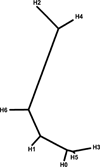Hypercontrols in genotype-phenotype analysis reveal ancestral haplotypes associated with essential hypertension
- PMID: 22371359
- PMCID: PMC3306465
- DOI: 10.1161/HYPERTENSIONAHA.111.176453
Hypercontrols in genotype-phenotype analysis reveal ancestral haplotypes associated with essential hypertension
Abstract
The angiotensinogen gene locus has been associated with essential hypertension in most populations analyzed to date. Increased plasma angiotensinogen levels have been proposed as an underlying cause of essential hypertension in whites; however, differences in the genetic regulation of plasma angiotensinogen levels have also been reported for other populations. The aim of this study was to analyze the relationship between angiotensinogen gene polymorphisms and haplotypes with plasma angiotensinogen levels and the risk of essential hypertension in the Mexican population. We genotyped 9 angiotensinogen gene polymorphisms in 706 individuals. Four polymorphisms, A-6, C4072, C6309, and G12775, were associated with increased risk, and the strongest association was found for the C6309 allele (χ(2)=23.9; P=0.0000009), which resulted in an odds ratio of 3.0 (95% CI: 1.8-4.9; P=0.000006) in the recessive model. Two polymorphisms, A-20C (P=0.003) and C3389T (P=0.0001), were associated with increased plasma angiotensinogen levels but did not show association with essential hypertension. The haplotypes H1 (χ(2)=8.1; P=0.004) and H5 (χ(2)=5.1; P=0.02) were associated with essential hypertension. Using phylogenetic analysis, we found that haplotypes 1 and 5 are the human ancestral haplotypes. Our results suggest that the positive association between angiotensinogen gene polymorphisms and haplotypes with essential hypertension is not simply explained by an increase in plasma angiotensinogen concentration. Complex interactions between risk alleles suggest that these haplotypes act as "superalleles."
Figures

Similar articles
-
Variants and haplotypes in angiotensinogen gene are associated with plasmatic angiotensinogen level in Mexican population.Am J Med Sci. 2011 Sep;342(3):205-11. doi: 10.1097/MAJ.0b013e3182121020. Am J Med Sci. 2011. PMID: 21629041 Free PMC article.
-
Association of the renin gene polymorphism, three angiotensinogen gene polymorphisms and the haplotypes with essential hypertension in the Mongolian population.Clin Exp Hypertens. 2010;32(5):293-300. doi: 10.3109/10641960903443517. Clin Exp Hypertens. 2010. PMID: 20662730
-
Genotype-phenotype analysis of angiotensinogen polymorphisms and essential hypertension: the importance of haplotypes.J Hypertens. 2010 Jan;28(1):65-75. doi: 10.1097/HJH.0b013e328332031a. J Hypertens. 2010. PMID: 19770777 Free PMC article.
-
The relationship between angiotensinogen gene polymorphisms and essential hypertension in a Northern Han Chinese population.Angiology. 2014 Aug;65(7):614-9. doi: 10.1177/0003319713491309. Epub 2013 May 28. Angiology. 2014. PMID: 23716723
-
[Role of the angiotensinogen gene for essential hypertension].Herz. 2000 Feb;25(1):15-25. doi: 10.1007/BF03044120. Herz. 2000. PMID: 10713906 Review. German.
Cited by
-
Prevalence and association of microalbuminuria in essential hypertensive patients.N Am J Med Sci. 2012 Aug;4(8):331-5. doi: 10.4103/1947-2714.99501. N Am J Med Sci. 2012. PMID: 22912940 Free PMC article.
-
Influence of genetic variation on plasma protein levels in older adults using a multi-analyte panel.PLoS One. 2013 Jul 23;8(7):e70269. doi: 10.1371/journal.pone.0070269. Print 2013. PLoS One. 2013. PMID: 23894628 Free PMC article.
-
A functional variant in ST2 gene is associated with risk of hypertension via interfering MiR-202-3p.J Cell Mol Med. 2017 Jul;21(7):1292-1299. doi: 10.1111/jcmm.13058. Epub 2017 Jan 25. J Cell Mol Med. 2017. PMID: 28121058 Free PMC article.
-
Association of mononucleotide polymorphisms of angiotensinogen gene at promoter region with antihypertensive response to angiotensin receptor blockers in hypertensive Chinese.J Renin Angiotensin Aldosterone Syst. 2019 Jan-Mar;20(1):1470320319827205. doi: 10.1177/1470320319827205. J Renin Angiotensin Aldosterone Syst. 2019. PMID: 30798697 Free PMC article.
-
Augmented intrarenal and urinary angiotensinogen in hypertension and chronic kidney disease.Pflugers Arch. 2013 Jan;465(1):3-12. doi: 10.1007/s00424-012-1143-6. Epub 2012 Aug 24. Pflugers Arch. 2013. PMID: 22918624 Free PMC article. Review.
References
-
- Inagami T. The renin-angiotensin system. Essays Biochem. 1994;28:147–164. - PubMed
-
- Jeunemaitre X, Soubrier F, Kotelevtsev YV, Lifton RP, Williams CS, Charru A, Hunt SC, Hopkins PN, Williams RR, Lalouel JM, Corvol P. Molecular basis of human hypertension: role of angiotensinogen. Cell. 1992;71:169–180. - PubMed
-
- Pan WH, Chen JW, Fann C, Jou YS, Wu SY. Linkage analysis with candidate genes: the Taiwan Young-Onset Hypertension Genetic Study. Hum Genet. 2000;107:210–215. - PubMed
Publication types
MeSH terms
Substances
Grants and funding
LinkOut - more resources
Full Text Sources
Medical

